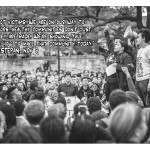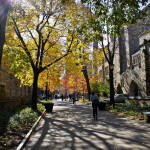I am the American heartbreak –
The rock on which Freedom
Stumped its toe –
The great mistake
That Jamestown made
Long ago.
–Langston Hughes
“You think it’s the hurricane? I think a dead man trying to tell a tale.”
Curtis T., a homeless man, was being interviewed by the New Haven Independent about an event that transpired the night before Halloween in 2012. A homeless woman named Katie Carbo was sleeping near an oak tree on the New Haven Green that had been uprooted by Hurricane Sandy when she discovered a human skull in the roots of the tree. It turned out that when all of the headstones were moved from the former cemetery, the bodies were left behind.
There are many more skulls cradled in the soil of the Green, more dry bones cracking open under the weight of time. Yale students tend to stay away from the Green, but it is not because of these dead bodies. My first lesson on why I should stay away from the Green came to me on my first day at Yale. My tour group was heading towards Old Campus when I asked my guide if the Green was Yale’s quad.
He scoffed. “That’s where the homeless people live. Don’t go there alone unless you want to get shot.”
One day in September I was headed to Wooster Square to get a latte from Fuel when I realized that I could cut through the Green to get there. Despite the advice of my tour guide, I decided to take the risk of getting shot to see what lay beneath the rumors and the scorn.
The New Haven Green is divided into two large rectangles of grass called the Upper Green and the Lower Green that are parallel to each other and separated by a busy street. When I step onto the Upper Green, the world around me turns murky green. Trees filter the sunlight into a shadowy gray. Benches line the paths, filled with the bodies of those who have nowhere to go. These are people who presumably cannot get a job, a home, or a break. So they sit. It is a warm day, so some bodies are curled up in a fetal position on the grass near the church. On the back wall of a church is a plaque with an inscription that reads:
IN THE MOMENT
IN THE TWINKLING OF AN EYE
AT THE LAST TRUMP
THE DEAD SHALL BE RAISED
“The dead shall be raised.” The people buried under the Green have stories to tell, but there are even more to be told about those who have walked on top of it. From the fall of 1839 to the summer of 1840, the African prisoners from the slave ship Amistad got their rationed exercise on its grass as they endured the trial to determine whether or not they were free. The jail that housed them was located on the edge of the Green, and people would pay 12 ½ cents to view the rebellious Africans who resisted the white authority that wanted to condemn them to a life of dehumanizing servitude. People paid to look at the slaves, but now it costs nothing to look at the remains of this legacy of oppression that sleep on the grass of the Green and smoke on its benches. Not every homeless person sleeping in the Green is the descendant of an enslaved African, but many of them are.
The sun is still perched in the sky, but a chill has passed through my bones. Only 15 minutes now. I am getting closer to the place where I can sit down and page through my Economics textbook. Wooster Square is only 15 minutes away. To get to the Square I pass through Brownstone Row on Chapel Street which is not open to traffic unless the driver lives in one of the historical houses that line either side of the street. This disconnection from the bustling city streets, this idyllic isolation finds its way to the cadence of my walk as I relax and slow my pace towards Wooster Square. The Square itself is surrounded by impressive historical homes on all sides. It is a public space, but is meant for those who have homes. There are many trees, but the same sun that shone on the New Haven Green is unequal in its distribution. Wooster Square is golden in the late afternoon.
Wooster Square was named after General David Wooster, a white man who died while serving in the the Revolutionary War. He graduated from Yale, a place that weaves itself tightly into many stories of New Haven, both past and present. Here in the present a white couple is lying in the grass as I walk by; their bicycles rest beside them. An elderly white woman sits in her wheelchair with her black caretaker beside her. They watch a group of children, some black, mostly not, run through the crunchy leaves that are just beginning to flutter from the trees.
What will it take for the people of New Haven to treat the New Haven Green and Wooster Square as equal places to play with their children, enjoy the sunshine, go on a date? While I cannot speak for all of New Haven, I know that when I walked through the Green I felt uncomfortable and unwelcome. I could not sit down next to the homeless man sleeping on the grass and pull out my Economics textbook for some reading.
That juxtaposition, that reminder of the inequality that America was founded on, makes us uneasy. And yet on many occasions as I walk through Wooster Square, I notice that I am the only black person in the park. On one such occasion, I glanced at the Nalgene water bottle in my hand with “Yale” boldly emblazoned on the side, and I gripped it a little tighter. It made me feel like I belonged, like it was my justification for being in a place that and General Wooster did not mean for me to be in.
Occupying space where you are not meant to be is a key tool in social progress. The “Occupy Wall Street” movement of 2012 was particularly felt in New Haven where the Green was home to the longest encampment of protesters in New England. They were protesting the corporate interests and the power imbalances in the U.S. that produce environments as starkly different as Wooster Square and the New Haven Green.
They were eventually evicted by the Proprietors, a private group started by the original Founders of New Haven that has owned the Green since 1641. Power has remained in the same hands for generations, and they were able to get the protestors evicted just in time for Yale’s Commencement. When people protest because of a problem in society, the people in power tend to solve this problem by moving the protesters and their problem out of sight. If there is ever a movement to make the Green more like Wooster Square, I am afraid that those in power may choose to simply move the homeless people out of sight without acknowledging that it is more complicated than that.
How do you solve a problem grounded in 500 years of original sin? We start by looking at the dry bones under the roots of the trees. The dead shall be raised, but they can only speak the truth about history with the help of the living.
by Elizabeth Spenst



Keep this piece very close by. It is the essence of the purpose of Down. The history of the green, the contast of the green and its history with Wooster, the buried souls and their struggle for purpose, respect and life. The quiet wondering of the writer to question where she fits in. Man’s inhumanity and the never ending pursuit of a place and a home. Great article!!
Absolutely wonderful stuff, Liz. Loved the bit about occupying spaces as the key to social progress.